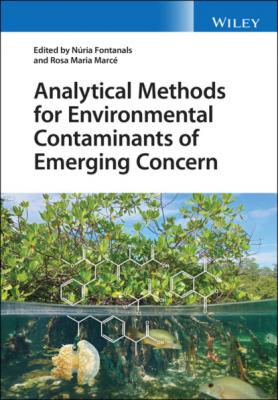Analytical Methods for Environmental Contaminants of Emerging Concern. Группа авторов
Читать онлайн.| Название | Analytical Methods for Environmental Contaminants of Emerging Concern |
|---|---|
| Автор произведения | Группа авторов |
| Жанр | Химия |
| Серия | |
| Издательство | Химия |
| Год выпуска | 0 |
| isbn | 9781119763888 |
List of abbreviations: ACN: acetonitrile; dSPE: dispersive solid-phase extraction; ESI: electrospray ionization; EtOAc: ethylacetate; FA: formic acid; FUSLE: focused ultrasonic solid-liquid extraction, HPLC: high-performance liquid chromatography; HRMS: high-resolution mass spectrometry; LCL: lowest calibrated level; LLE: liquid-liquid extraction; MAE: microwave-assisted extraction; MDL: method detection limit; MQL: method quantification limit; MRM: multiple reaction monitoring; MS: mass spectrometry; MS/MS: tandem mass spectrometry; NSAIDs: non-steroidal anti-inflammatory drugs; SIM: selected ion monitoring; SPE: solid-phase extraction; SRM: selected reaction monitoring; UAE: ultrasound-assisted extraction; UPLC: ultra-performance liquid chromatography; UV: ultraviolet light.
2.4 Conclusion and Future Trends
Despite the undoubtedly impressive development of research methodologies that has been made, there are still numerous methodological challenges to overcome. Isolation and pre-concentration of analytes remains a key step in environmental analysis. Significant dilution of pharmaceuticals in seawater samples and condensation of contaminants in wastewater require modification of existing SPE procedures. Furthermore, most SPE sorbents are disposable, which is costly and contrary to the principles of green analytical chemistry. Therefore, the development of suitable sample preparation methods that fit within the principles of green analytical chemistry remains a necessary and challenging task. Alternative sampling methods, such as composite samples or passive samplers, can provide a more representative chemical profile. In addition, an inappropriate extraction method can affect matrix effects, which are indicated as a major problem in the analysis of trace pharmaceuticals using the LC/MS technique. Matrix effects can limit the usefulness of coupled techniques in quantitative analysis, especially when performing compound determinations in environmental, food, wastewater or biological samples. Typically, suppression or enhancement of the analyte response is accompanied by reduced precision and accuracy of subsequent measurements. Various ways to reduce the influence of matrix components, including the use of isotopically labelled standards, changes in mass spectrometer operating conditions and chromatographic conditions, and modifications to the sample extraction procedure can be used [31]. If matrix effects cannot be minimized sufficiently, appropriate calibration techniques to determine matrix effect values are currently in practice. Further work in this area should be carried out and, in particular, standardisation of methodologies should be attempted.
In recent years, the performance of LC instrumentation, in particular HRMS, has increased, and other tools, e.g. HILIC and IMS, have been recognized as promising additions for the analysis of difficult compounds. It is also necessary to carry out research primarily aimed at the identification of a broad spectrum of pharmaceuticals, including the use of non-target and suspect screening approaches. Many different data processing strategies have been developed in recent years. However, structure elucidation remains a difficult and time-consuming task. In the future, it is likely that data processing and software capabilities will increase, enabling approaches to process large amounts of data. The reproducibility and comparability of non-target and suspect screening is already being discussed and should become an important research topic in the near future.
References
1 1 Roig, B. and D’Aco, V. (2016). Distribution of pharmaceutical residues in the environment. In: Pharmaceuticals in the Environment, 1st edn (ed., R.E. Hester and R.M. Harrison), 34–69. Cambridge: Royal Society of Chemistry. doi: 10.1039/9781782622345.
2 2 Kümmerer, K. (2008). Pharmaceuticals in the environment – a brief summary. In: Pharmaceuticals
